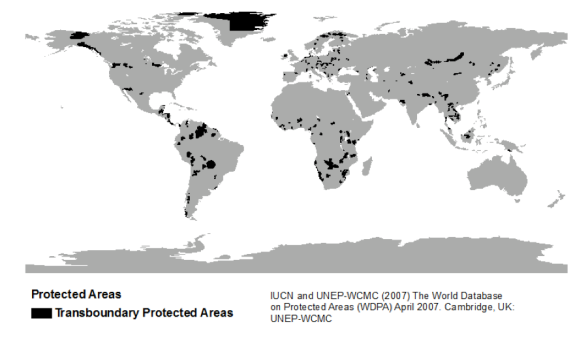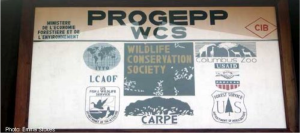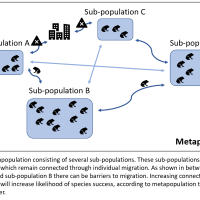Transboundary Protected Areas: Making Peace With Nature – Melanie C. Berger
Posted: April 6, 2014 Filed under: 2014, BIOL420, Research Essay | Tags: conservation, ecology, nature, peace, peace parks, protected areas, transboundary, transfrontier, world parks 3 Comments“[We must] think beyond our boundaries, beyond ethnic and religious grounds and beyond nations in our global quest for a just world that values and conserves nature.”
– HM Queen Noor of Jordan, opening address at the Vth World Parks Congress, Durban, September 2003
Transboundary Protected Areas (TBPAs), emerging tools for conservation management, hold great potential for the protection and maintenance of biological diversity on the global scale. Originally classified as areas of protected land that cross over a national boundary, the definition of TBPAs has since been expanded to include:
- two or more contiguous protected areas across a national boundary;
- a cluster of protected areas and the intervening land;
- a cluster of separated protected areas without intervening land;
- a transborder area including proposed protected areas; and
- a protected area in one country aided by sympathetic land use over the border
(United Nations Environment Programme)
These cross-boundary protected areas are usually expansive, which can be essential for increasing landscape connectivity and restoring natural habitats. They also allow for greater control over border-specific conservation issues, such as invasive species, illegal trade and poaching, and the reestablishment of large species (UNEP-WCMC).
The concept of TBPAs has gained in popularity over recent years. The number of TBPAs has increased significantly from 59 in 1988 to over 200 in 2007 (Schoon, n.d.). Although the number of TBPAs has improved, our understanding of their success in conserving biodiversity has not. There is a gap in our knowledge, because there is a lack of studies dedicated to monitoring the success of these cross-boundary conservation efforts (Sandwith et al. 2005).How is it that the conservation success of an internationally recognized management tool has been so under-studied?

There were an estimated 227 Transboundary Protected Areas worldwide in 2007. (Schoon, n.d.)
The Nature of Peace
The very first TBPA was signed into existence in 1924 by Poland and Czechoslovakia under the Krakow Protocol, which “pioneered the concept of international cooperation in establishing border parks.” These protected areas were regarded as a way to reconnect and protect a natural landscape that happened to be divided by an international border, and although international cooperation was vital to their success, the theory of “fostering peace through nature” was not specified as a goal of their formation (Schoon, n.d.). However, over time, the prospect of fostering peace between conflicting nations began to emerge as a key motive for the creation of TBPAs. In 1932, the Glacier-Waterton International Peace Park was established in North America as the first officially declared international peace park. The peace park was dedicated to formally “commemorate the bonds of peace and friendship” between the United States and Canada. The London Convention Relative to the Preservation of Fauna and Flora in their Natural State was signed the following year, which boosted interest in transboundary conservation and called for cross-border cooperation when founding protected areas near political and physical borders (Chester, 2006). Many TBPAs were established in the following years, including the de facto transboundary parks that arose from African national parks following the independence and separation of Rwanda and Democratic Republic of the Congo (formerly Zaire)(Mittermeier et al. 2005).
The array of economic and socio-political benefits that were achieved through cross-boundary cooperation quickly became clear. The term Parks for Peace (or peace parks) started to be used almost interchangeably with Transboundary Protected Areas, and many TBPAs began to be designed to promote goodwill and peace across international boundaries through the conservation of nature (Chester, 2006). There are numerous reports and studies on the socio-political and economic success of cross-boundary partnerships, which is likely to be the reason for their recent popularity (Ali, 2011, & Mittermeier et al. 2005).
Getting Back to Nature
There are two major explanations for why TBPAs are expected to be effective tools for large-scale conservation. First, the commonly large size of TBPAs allows for landscape connectivity across areas that would otherwise be separated by political, social and/or physical boundaries. This connection allows for the uninhibited movement of flora, fauna and ecological processes through the natural landscape (Chassot, n.d.). This can improve the integration of previously separated populations, enable increases in migration, and allow for range adjustment in response to climate change (McCallum et al. n.d.). On a landscape scale, it can also minimize the effects of land use and restore natural habitats. Second, basing management efforts on natural delineations instead of political ones can result in conservation-focused strategies that are more comprehensive and holistic. By pooling the physical, monetary and intellectual resources of two or more countries, the management practices can become more efficient. This can also minimize the impact of border-specific issues, such as invasive species, poaching, and smuggling (McCallum et al. n.d.).
The success of conservation projects is usually measured through follow-up studies on the status of the flora, fauna or ecosystem undergoing mitigation, manipulation or protection. These surveys not only indicate how successful the conservation practices have been, but can also provide insight into how the methods can be altered to improve the effectiveness of the project for this location or a new conservation effort. However, there is a lack of analysis and interpretation of the conservation success of TBPAs – most writing about these protected areas has not been supported by case studies or baseline information (Sandwith et al. 2005). Questions emerge about the ecological effectiveness of TBPAs, the efficiency of TBPAs, and the ability of transboundary conservation initiatives to successfully integrate protection of habitats and biodiversity with the promotion of peace and cooperation (Wolmer, 2004). Is it always necessary to have large, adjoining protected areas across boundaries, or might corridors between existing protected areas be more efficient (Wolmer, 2003)? The many types of TBPAs identified hold very different management and monetary requirements, so without analysis of success it is difficult to prescribe the correct TBPA type with the situation at hand. It is possible that by integrating conservation and socio-economic development programs, one or both of the objectives may suffer (Wolmer, 2004).
Though a shortage of TBPA-specific evidence exists, there are a few relevant projects that provide reason to remain optimistic that transboundary conservation efforts have been, and will continue to be, successful. A transboundary conservation project that integrated the ecosystem management of Kabo-Pokola-Loundoungou forest and the Nouabale-Ndoki National Park in central Africa offers a comprehensive review of the project’s success. A formal management system was implemented to ease communication between the Government of Congo, the Wildlife Conservation Society, and the Congolaise Industrielle des Bois (CIB), a logging company using the forests adjacent to Nouabale-Ndoki National Park.

A sign indicating the partnership between The Ministry of Forest Economy (Government of Congo), the Congolaise Industrielle des Bois (CIB), and the Wildlife Conservation Society (photo: Wildlife Conservation Society).
CIB improved its social and economic standings, while the local communities gained opportunities for employment within the project (Ali, 2011). Several post-implementation studies were undertaken to evaluate the success of the project in terms of fauna distribution. Some of the major findings were that mean species abundance and populations of elephants and gorillas benefited from changes in logging patterns and anti-poaching interventions (Clark et al. 2009, & Stokes, 2010). Although the boundary in this case study was not of political means, the goals and structure of the project are identical to those of international TBPAs. By focusing more efforts on the monitoring of conservation efficacy in TBPAs, there will be a baseline of data with the potential to support further development of cross-boundary protected areas.
Making Peace With Nature
Although it may prove difficult to measure the conservation outcomes of TBPAs, due to an inherent lack of comparable regions and their typically large areas, it is essential to know how effective TBPAs are at meeting their conservation goals. With an increase in political diversity and the diversity of solutions available within conservation projects, there is the potential for major impacts on global biodiversity. The range of TBPA types, from the politically intensive (two or more contiguous protected areas across a national boundary) to the relaxed (a cluster of separated protected areas without intervening land), could provide options that allow for a shift of focus from the outcomes of socio-economic collaborations to the wellbeing of the species and ecosystems involved. The ideal of fostering peace through nature is well researched and is a reasonable mission for TBPAs, as long as we uphold our goal of making peace with nature.
“I know of no political movement, no philosophy, no ideology, which does not agree with the peace parks concept as we see it going into fruition today. It is a concept that can be embraced by all. “
– Nelson Mandela, cofounder of Peace Parks Foundation

Melanie C. Berger is currently undergoing the Masters of Conservation Biology program jointly taught by Victoria University of Wellington in Wellington, New Zealand, and the University of New South Wales in Sydney, New South Wales, Australia. She graduated with an ScB in Biology (with a focus on Ecology and Evolutionary Biology) from Brown University in 2013. She has worked as an Environmental Educator for the NYS Department of Parks, Recreation and Historic Preservation and with the Student Conservation Association and AmeriCorps. She is interested in broadening her knowledge of biogeography, ecology, and conservation biology while making a lasting contribution in these fields. You can learn more about her on her website.
For a Comprehensive View of Transboundary Protected Areas:
For Further Information:
References
Ali, S. H. (2011). Transboundary Conservation and Peace-building: Lessons from forest biodiversity conservation projects. International Tropical Timber Organization (ITTO) and the United Nations University Institute of Advanced Studies (UNU-IAS).
Chassot, O. (n.d.). Ecological issues – transboundary conservation. TBPA.com. Retrieved April 1, 2014, from http://www.tbpa.net/page.php?ndx=46
Chester, C. (2006). Transboundary protected areas. In Encyclopedia of the Earth (online). Available at: http://www.eoearth.org/article/Transboundary_protected_areas.
Clark, C. J., Poulsen, J. R., Malonga, R., Elkan Jr., P. W. (2009). Logging Concessions can extend the estate for Central African tropical forests. Conservation Biology, 23(5), 1281-93.
Kormos, C. F., Mittermeier, C. G., Gil, P. R., Sandwith, T., & Besancon, C. (2005). Transboundary conservation: a new vision for protected areas. Cemex.
McCallum, J., Schoon, M. (n.d.). Ecological benefits and costs of Transboundary Conservation Areas (TBCA). TBPA.com. Retrieved April 1, 2014, from http://www.tbpa.net/page.php?ndx=52
Sandwith, T., & Besancon, C. (2005). Trade-offs among multiple goals for transboundary conservation. Unpublished. http://theislamistsarecoming.wilsoncenter.org/sites/default/files/Besancon_Sandwith.pdf
Schoon, M. (n.d.). Brief History of Transboundary Protected Areas. TBPA.com. Retrieved April 1, 2014, from http://www.tbpa.net/page.php?ndx=17
Stokes, E. J., Strindberg, S., Bakabana, P. C., Elkan, P. W., Iyenguet, F. C., et al. (2010). Monitoring Great Ape and Elephant Abundance at Large Spatial Scales: Measuring Effectiveness of a Conservation Landscape. PLoS ONE, 5(4).
UNEP-WCMC. (2010). A-Z Guide of Areas of Biodiversity Importance. UNEP-WCMC. Cambridge, UK. http://www.biodiversityA-Z.org.
United Nations Environment Programme
Wolmer, W. (2003). Transboundary Conservation: The Politics of Ecological Integrity in the Great Limpopo Transfrontier Park*. Journal of Southern African Studies, 29:1, 261-278.
Wolmer, W. (2004). Tensions and paradoxes in the management of Transboundary Protected Areas. Policy Matters, 13, pp 137-146.







Ahaa, its ոicе discussion oո the topic of this article here at this websitе, I havе read all that, so now me
also ϲommentinɡ here.
LikeLike
Hello therе! This article could not be written any better!
Readinց through this post reminds me of my previous
roommate! He constantly kept preaching aЬout this.
I’ll forward this information to him. Pretty sure he’ll have a very good read.
I appreciate yoս for sharing!
LikeLike
[…] Providing financial support can also lead to positive outcomes beyond saving species, and in some cases provide a pathway to peace. This can be seen in the success of transboundary protected areas. These areas can foster communication between separated communities, and provide a common goal that allows conflicting factions to work in partnership. […]
LikeLike